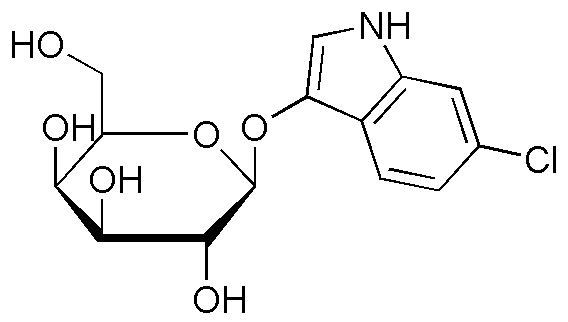6-Chloro-3-indolyl a-D-galactopyranoside is widely utilized in research focused on:
- Biochemical Assays: This compound serves as a substrate in enzyme assays, particularly for studying galactosidases. Its use allows researchers to measure enzyme activity effectively, providing insights into metabolic pathways.
- Plant Research: It is employed in plant biology to investigate gene expression and metabolic processes. By using this compound, scientists can analyze how plants respond to various stimuli, enhancing our understanding of plant physiology.
- Pharmaceutical Development: The compound is valuable in drug discovery, particularly in developing therapeutics targeting specific enzymes. Its specificity can lead to more effective treatments with fewer side effects compared to broader-spectrum compounds.
- Food Industry Applications: It can be utilized in food science to study carbohydrate metabolism and fermentation processes, helping improve food preservation techniques and flavor development.
- Diagnostic Tools: This chemical is also used in the development of diagnostic assays for detecting certain diseases, providing a reliable method for early diagnosis and monitoring of health conditions.
General Information
Properties
Safety and Regulations
Applications
6-Chloro-3-indolyl a-D-galactopyranoside is widely utilized in research focused on:
- Biochemical Assays: This compound serves as a substrate in enzyme assays, particularly for studying galactosidases. Its use allows researchers to measure enzyme activity effectively, providing insights into metabolic pathways.
- Plant Research: It is employed in plant biology to investigate gene expression and metabolic processes. By using this compound, scientists can analyze how plants respond to various stimuli, enhancing our understanding of plant physiology.
- Pharmaceutical Development: The compound is valuable in drug discovery, particularly in developing therapeutics targeting specific enzymes. Its specificity can lead to more effective treatments with fewer side effects compared to broader-spectrum compounds.
- Food Industry Applications: It can be utilized in food science to study carbohydrate metabolism and fermentation processes, helping improve food preservation techniques and flavor development.
- Diagnostic Tools: This chemical is also used in the development of diagnostic assays for detecting certain diseases, providing a reliable method for early diagnosis and monitoring of health conditions.
Documents
Safety Data Sheets (SDS)
The SDS provides comprehensive safety information on handling, storage, and disposal of the product.
Product Specification (PS)
The PS provides a comprehensive breakdown of the product’s properties, including chemical composition, physical state, purity, and storage requirements. It also details acceptable quality ranges and the product's intended applications.
Certificates of Analysis (COA)
Search for Certificates of Analysis (COA) by entering the products Lot Number. Lot and Batch Numbers can be found on a product’s label following the words ‘Lot’ or ‘Batch’.
*Catalog Number
*Lot Number
Certificates Of Origin (COO)
This COO confirms the country where the product was manufactured, and also details the materials and components used in it and whether it is derived from natural, synthetic, or other specific sources. This certificate may be required for customs, trade, and regulatory compliance.
*Catalog Number
*Lot Number
Safety Data Sheets (SDS)
The SDS provides comprehensive safety information on handling, storage, and disposal of the product.
DownloadProduct Specification (PS)
The PS provides a comprehensive breakdown of the product’s properties, including chemical composition, physical state, purity, and storage requirements. It also details acceptable quality ranges and the product's intended applications.
DownloadCertificates of Analysis (COA)
Search for Certificates of Analysis (COA) by entering the products Lot Number. Lot and Batch Numbers can be found on a product’s label following the words ‘Lot’ or ‘Batch’.
*Catalog Number
*Lot Number
Certificates Of Origin (COO)
This COO confirms the country where the product was manufactured, and also details the materials and components used in it and whether it is derived from natural, synthetic, or other specific sources. This certificate may be required for customs, trade, and regulatory compliance.


